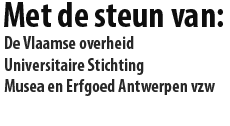A.K.L. THIJS
Een onbescheiden blik in de portefeuille van de Volkskunde-redacteur: Victor de Meyere (1873-1938) bespied met het bricoleren met kopij
Summary: An indiscreet look onto the portfolio of a Volkskunde editor: watching Victor de Meyere (1873-1938) tinkering with a copy.
Unedited copy of Victor de Meyere’s portfolio for volume 1938 of the Volkskunde magazine
Recently, a printing ready copy was found for issue 4-6 of volume 1938 of the Nederlandsch Tijdschrift voor Volkskunde. This issue was never published due to the sudden death of editor and owner V. de Meyere at the end of 1938. The manuscript contains folk tales, songs and information about folk belief and children’s games. It provides us with an impression of what 1938 folklorists were interested in. It also shows how V. de Meyere proceeded when laboriously composing an issue of his magazine.
The fact that his texts remained unpublished, is characterizing for the discontinuity between the Nederlandsch Tijdschrift voor Volkskunde and the Nieuwe Reeks van Volkskunde which appeared as from 1940.
,,
H. GEYBELS
Christelijke privé- en massadevotie: verrassend postmodern!
Summary: Christian private and mass devotion; surprisingly post modernistic!
After a critical justification of the formulation of the title, the author moves away from the pessimism of many intellectuals as if the days of Christianity were counted. The fact that quantitative information concerning religious perception is susceptible to relativization and differentiation is illustrated by means of examples: the success of small chapels, processions, rituals concerning the life cycle and the cult of Maria. Apparently, a paradox has arisen between decay and revival. He explains this surprising contradiction by analyzing the post modernistic, fragmented culture (of belief). It is characterized by detraditionalization, pluralization and individualization.
Constant elements in the contemporary Christian private and mass devotion are the many personal ritual customs, texts, chants, music and saint images. They are also frequently identified in non-acknowledged cult places are so to speak readily available for modern man.
,
M. A. VAN DEN BROEK
Holland en de Hollanders in Duitse spreekwoorden en gezegden.
Summary: Holland and the Dutch in German proverbs and sayings
The sixteenth century marks the tradition of German proverbs and saying in which an image is reflected of Holland and its people. In the beginning, it is mostly the trade spirit and his sense for business that are positively portrayed. However, the Dutchman is also viewed as rude and impolite. In the eighteenth century – a period of cultural and economic decline – the image becomes distinctly negative.
The once admired trade spirit is increasingly considered as a petit bourgeois mentality and the Dutchman is portrayed as a narrow-minded, money coveting creature, stopped by nothing or by nobody.
Other negative aspects found in proverbs and sayings are the noisy behavior, an unrestrained mentality and an innate rudeness.
Stupidity and anxiety are also considered to be typically Dutch and are proverbially exposed.
By far the most proverbs and sayings come from the border region and are given in the original dialect version.
An alphabetic register and an overview of the most quoted sources complete the picture.
,
M.M.A.C. LANGENHUIJSEN
Genealogie en curriculum van een fabeldier: de basilisk
Summary: Genealogy and the curriculum of a mythical animal: the basilisk
At the beginning of our era, the basilisk, a mythical animal, was thought to be a snake. The king cobra had probably stood model for the animal. About a thousand years later, it appears to have undergone a metamorphosis into a cock with a snake’s tail. The habit of picturing snakes with wings and/or claws, but also the Mesopotamic scorpion birdman, might have played some role in the transfiguration. As the mythical animal sprouted from nature, so did it return to it. The taxonomist Linnaeus gave a group of basilisk-like iguanas the generic name Basiliscus. The real basilisk has one other mythical quality: its ability to run an water.
,

